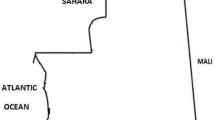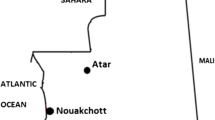Abstract
Falciparum Malaria is hyperendemic in southern Nigeria and chloroquine resistance is an increasing problem. Therefore, the parasitological and haematological response to treatment with amodiaquine was studied in children under 5 years during a 14-day follow-up. Of 105 children who accomplished the study (out of 114 who were enrolled), 95.3% were parasite-negative on thick blood film on day 7, which decreased to 89.5% on day 14. The haemoglobin levels increased on average by 1.3% on day 14 (±1.9) and more pronounced in children with anaemia < 10 g/dl on enrolment. The number of patients with adverse events (mainly pruritus and nausea) was few. This study shows that amodiaquine is effective, safe and affordable in an area with high resistance to chloroquine.
Similar content being viewed by others
References
Antia-Obong OE, Alaribe AA, Young MU, Bassy A, Etim BV (1997) Chloroquine-resistant Plasmodium falciparum malaria among children in Calabar, south eastern Nigeria. Trop Doctor 27:146–149
Brasseur P, Guiguemde R, Diallo S, Guiyedi V, Kombila M, Ringwald P, Olliario P (1999) Amodiaquine remains effective for treating uncomplicated malaria in West and Central Africa. Trans R Trop Med Hyg 93:645–650
Ekvall H, Premji Z, Björkmann A (1998) Chloroquine treatment for uncomplicated malaria in an area with drug resistance: early treatment failure aggravates anaemia. Trans R Trop Med Hyg 92:556–560
Ezedinachi E (1996) In vivo efficacy of chloroquine, halofantrine, pyrimethamine- sulphadoxine and qinghaosu in the treatment of malaria in Calabar, Nigeria. Central Afric J Med 42:109–111
Falade CO, Salako LA, Sowunmi A, Oduola AMJ, Larcier P (1997) Comparative efficacy of halofantrine, chloroquine and sulphadoxine- pyrimethamine for treatment of acute uncomplicated falciparum malaria in Nigerian children. Trans R Trop Med Hyg 91:58–62
Guiyedi V, Koko J, Bouyou AM, Mabika MM, Matsiegui PB, Traore B, Kombila M (2001) Evaluation of efficacy and tolerance of amodiaquine versus chloroquine in the treatment of uncomplicated malaria outbreak in children of Gabon. Bull Soc Path Exot 94:253–257
Hawley SR, Bray PG, Park BK, Ward SA (1996) Amodiaquine accumulation in Plasmodium falciparum as a possible explanation for its superior antimalarial activity over chloroquine. Mol Biochem Parasitol 80:15–25
Oliario P, Nevill C, LeBras J, Ringwald P, Mussano P, Garner P, Brasseur P (1996) Systematic review of amodiaquine treatment in uncomplicated malaria. Lancet 348:1196–1201
Oyegun CU (1999) Climate, relief and drainge. In: Alagoa EJ (ed) The land and people of Bayelsa state. Onyoma research publications, pp 31–44
Pradines B, Tall A, Parzy D, Spiegel A, Fu T, Hienne R, Trape JF, Doury JC (1998) In-vitro activity of pyronaridine and amodiaquine against African isolates (Senegal) of Plasmodium falciparum in comparison with standard antimalarial drugs. J Antimicrob Chem 42:333–339
Ringwald P, Bickii J, Basco LK (1998) Amodiaquine as the first line treatment of malaria in Yaounde, Cameroon. Trans R Trop Med Hyg 92:212–213
Shretta R, Omumbo J, Rapuoda B, Snow RW (2000) Using evidence to change antimalarial drug policy in Kenya. Trop Med Int Health 11:755–764
Sowunmi A, Salako LA (1992) Evaluation of the relative efficacy of various antimalarial drugs in Nigerian children under five years of age suffering from acute uncomplicated falciparum malaria. Ann Trop Med Parasitol 86:1–8
Sudre P, Breman JG, McFarland D, Koplan JP (1992) Treatment of Chloroquine-resistant malaria in african children: a cost-effectiveness analysis. Int J Epidemiol 21:146–154
Trape JF (2001) The public health impact of chloroquine resistance in Africa. Am J Trop Med Hyg 64:1–25
Van Dillen J, Custers M, Wensink A, Wouters van Voorhuizen T, Voorn W, Khan B (1999) comparison of amodiaquine and sulphadoxine–pyrimethamine as first line treatment of falciparum malaria in Kenya. Trans R Trop Med Hyg 93:185–188
WHO (1996) Assessment of therapeutic efficacy of antimalarial drugs for uncomplicated falciparum malaria in areas with intense transmission WHO/96:1077
Acknowledgements
The results presented in this paper are part of a medical thesis by Jens Graupner
Author information
Authors and Affiliations
Corresponding author
Rights and permissions
About this article
Cite this article
Graupner, J., Göbels, K., Grobusch, M.P. et al. Efficacy of Amodiaquine in uncomplicated falciparum malaria in Nigeria in an area with high-level resistance to Chloroquine and Sulphadoxine/Pyrimethamine. Parasitol Res 96, 162–165 (2005). https://doi.org/10.1007/s00436-005-1325-7
Received:
Accepted:
Published:
Issue Date:
DOI: https://doi.org/10.1007/s00436-005-1325-7




